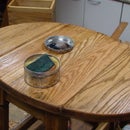Introduction: Homemade Woodworking Dividers
Woodworking dividers are some of the handiest tools you can have in your tool drawer. New ones are easy to find, but I prefer the older ones. Sadly, the good ones are pretty rare and can be quite expensive when you buy them from a tool collector (that's the thing about collectors: they hate selling stuff and love collecting it). Now if you know me, you know that I'm always in for a challenge, and that I love building tools.
So starting with nothing - a piece of junk mild steel, a few old parts and an old brass bolt - I went to work and these dividers came out. I'll show you how you can make them as well, if you're in for a challenge of course!
Step 1: Making the Legs
As with most tools, carbon steel is preferred, but for this build I use a scrap of common mild steel. Mild steel can be bent a lot easier than high-carbon steel, which comes in handy later on.
I cut a strip of steel from a stock piece I once got from a car builder. He was a hobbyist and had all sorts of cool stuff laying around. He was so nice to give me a piece to experiment with.
I cut the strip in half so I had two pieces for the legs. I then clamped them together and trued them up on the bench grinder. With an angle grinder, the bench grinder and a few files, I started shaping the legs. This comes down to cutting a corner off the end to form a sharp tip, and rounding the ends of the legs.
I decided to drill all the holes at once, so I clamped the legs together with a pair of vise-grips and used a drill press to drill the holes. After that, I tapped the lower ones for the adjustment mechanism. The holes at the top (ends of the legs) were left untapped. This ensures free movement later on.
Step 2: Refining the Legs
After tapping, it was time for some refinement. I filed out the grinding marks with a diamond file and sanded the whole ordeal with 180 and 400 grit sandpaper. After that I used a buffing wheel to give the legs a true mirror polish. Some tips on that:
- always work in one direction. That goes for filing, buffing and sanding.
- whenever you change a grit size, change direction. File straight across the original tool marks, then sand straight across the file marks. Then sand straight across those sanding marks. Change your grit, change direction.
- I always use (80), 180, 400 grit sandpaper and a buffing wheel.
- When using the buffing wheel, buff with a bit of pressure across the sanding marks, then really lightly across those. I always let the tool 'float' on top of the buffing wheel for a long time, but this is pretty dangerous. You could end up with a pair of dividers in your butt. Don't fool around.
- You can also use different grits of buffing compound.
- Detailed description: File along the length, use 180 across the tool, 400 grit along the length, Heavy buffing across and a light buffing along the length. Planning for this last step makes everything a bit easier.
Step 3: The Foundation of the Adjustment Mechanism
It took me a while to figure out what those weird things were that I used to connect the legs with the bolt. Actually, I didn't figure it out at all. What are those things? Luckily, a subscriber of mine said they were from an old bicycle brake. This once again proves the foundation of toolbuilding: nothing is trash and nothing should be thrown away. My grandfather once saved the mirrors of his old lorry, and left my grandma puzzled as to what he wanted to do with the old rubbish. Years later, after he came home from work, my grandmother told him a rare type of bird had baby birds in a nest on top of the doorbell, and how she wished she could see into the nest. Grandpa quickly rushed to his old shed (where he spent most of his free time) and came back with a long pole that had one of his old lorry mirrors screwed to it. This allowed them to see into the nest effortless, without disturbing the birds too much. My grandma never complained of my grandpa saving old stuff ever again.
Back to tool building. I put the bike screws in the chuck on my lathe and filed out the hex key slot with the machine turning. Cutting them off with a hacksaw might have been faster in the hindsight. After that, I sanded and polished them. The last step is tapping the holes, so the bolt can go through. I was lucky that the bolt, the tap and the holes were all of the same overall size. This really made things easier.
Step 4: Making It All Work
It is time for the final steps! I connected the legs with a brass bolt and nut. After I cut off the excess, I peened the end of the bolt over so it won't come apart. Using the lathe, I filed and sanded a very old brass bolt into a turning knob. After buffing it out, I put it through the tapped holes in the bike screws, with a spring in between the two of them. That's all it took to make the dividers! I only forgot to mention that I had to bend the legs over with a rubber mallet and anvil, or else they wouldn't touch.













